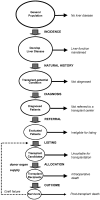Sociodemographic differences in early access to liver transplantation services
- PMID: 19645706
- PMCID: PMC2880404
- DOI: 10.1111/j.1600-6143.2009.02737.x
Sociodemographic differences in early access to liver transplantation services
Abstract
The question of whether health care inequities occur before patients with end-stage liver disease (ESLD) are waitlisted for transplantation has not previously been assessed. To determine the impact of gender, race and insurance on access to transplantation, we linked Pennsylvania sources of data regarding adult patients discharged from nongovernmental hospitals from 1994 to 2001. We followed the patients through 2003 and linked information to records from five centers responsible for 95% of liver transplants in Pennsylvania during this period. Using multinomial logistic regressions, we estimated probabilities that patients would undergo transplant evaluation, transplant waitlisting and transplantation itself. Of the 144,507 patients in the study, 4361 (3.0%) underwent transplant evaluation. Of those evaluated, 3071 (70.4%) were waitlisted. Of those waitlisted, 1537 (50.0%) received a transplant. Overall, 57,020 (39.5%) died during the study period. Patients were less likely to undergo evaluation, waitlisting and transplantation if they were women, black and lacked commercial insurance (p < 0.001 each). Differences were more pronounced for early stages (evaluation and listing) than for the transplantation stage (in which national oversight and review occur). For early management and treatment decisions of patients with ESLD to be better understood, more comprehensive data concerning referral and listing practices are needed.
Conflict of interest statement
The contributing authors have no conflicts of interest, including financial interests and relationships and affiliations relevant to the subject of the manuscript.
Figures

Similar articles
-
Black Patients Have Unequal Access to Listing for Liver Transplantation in the United States.Hepatology. 2021 Sep;74(3):1523-1532. doi: 10.1002/hep.31837. Hepatology. 2021. PMID: 33779992
-
Factors Associated With Access to and Receipt of Liver Transplantation in Veterans With End-stage Liver Disease.JAMA Intern Med. 2021 Jul 1;181(7):949-959. doi: 10.1001/jamainternmed.2021.2051. JAMA Intern Med. 2021. PMID: 34028505 Free PMC article.
-
Use of Population-based Data to Demonstrate How Waitlist-based Metrics Overestimate Geographic Disparities in Access to Liver Transplant Care.Am J Transplant. 2016 Oct;16(10):2903-2911. doi: 10.1111/ajt.13820. Epub 2016 May 17. Am J Transplant. 2016. PMID: 27062327 Free PMC article.
-
A scoping review of inequities in access to organ transplant in the United States.Int J Equity Health. 2022 Feb 12;21(1):22. doi: 10.1186/s12939-021-01616-x. Int J Equity Health. 2022. PMID: 35151327 Free PMC article.
-
Geographic disparities in access to liver transplantation.Liver Transpl. 2023 Sep 1;29(9):987-997. doi: 10.1097/LVT.0000000000000182. Epub 2023 May 29. Liver Transpl. 2023. PMID: 37232214 Free PMC article. Review.
Cited by
-
Patient Perspectives of High-Quality Care on the Liver Transplant Waiting List: A Qualitative Study.Liver Transpl. 2020 Feb;26(2):238-246. doi: 10.1002/lt.25645. Epub 2019 Sep 25. Liver Transpl. 2020. PMID: 31553123 Free PMC article.
-
Gender disparities in transplantation.Curr Opin Organ Transplant. 2021 Oct 1;26(5):513-520. doi: 10.1097/MOT.0000000000000909. Curr Opin Organ Transplant. 2021. PMID: 34343154 Free PMC article. Review.
-
Sex-based disparities in liver transplant rates in the United States.Am J Transplant. 2011 Jul;11(7):1435-43. doi: 10.1111/j.1600-6143.2011.03498.x. Am J Transplant. 2011. PMID: 21718440 Free PMC article.
-
Mitigating Health Disparities in Transplantation Requires Equity, Not Equality.Transplantation. 2024 Jan 1;108(1):100-114. doi: 10.1097/TP.0000000000004630. Epub 2023 May 5. Transplantation. 2024. PMID: 38098158 Free PMC article.
-
Geographic variation in utilization of deceased donor livers in the United States in the era of advanced perfusion.Liver Transpl. 2025 Jul 15:10.1097/LVT.0000000000000687. doi: 10.1097/LVT.0000000000000687. Online ahead of print. Liver Transpl. 2025. PMID: 40658771 Free PMC article.
References
-
- Majeske RA. Transforming objectivity to promote equity in transplant candidate selection. Theor Med. 1996;17:45–49. - PubMed
-
- Milford EL. Organ transplantation—barriers, outcomes, and evolving policies. JAMA. 1998;280:1184–1185. - PubMed
-
- Navaneethan SD, Singh S. A systematic review of barriers in access to renal transplantation among African Americans in the United States. Clin Transplant. 2006;20:769–775. - PubMed
-
- Ubel PA, Loewenstein G. Public perceptions of the importance of prognosis in allocating transplantable livers to children. Med Dec Making. 1996;16:234–241. - PubMed
-
- Ubel PA, Caplan AL. Geographic favoritism in liver transplantation—unfortunate or unfair? N Engl J Med. 1998;339:1322–1325. - PubMed
Publication types
MeSH terms
Grants and funding
LinkOut - more resources
Full Text Sources
Medical

